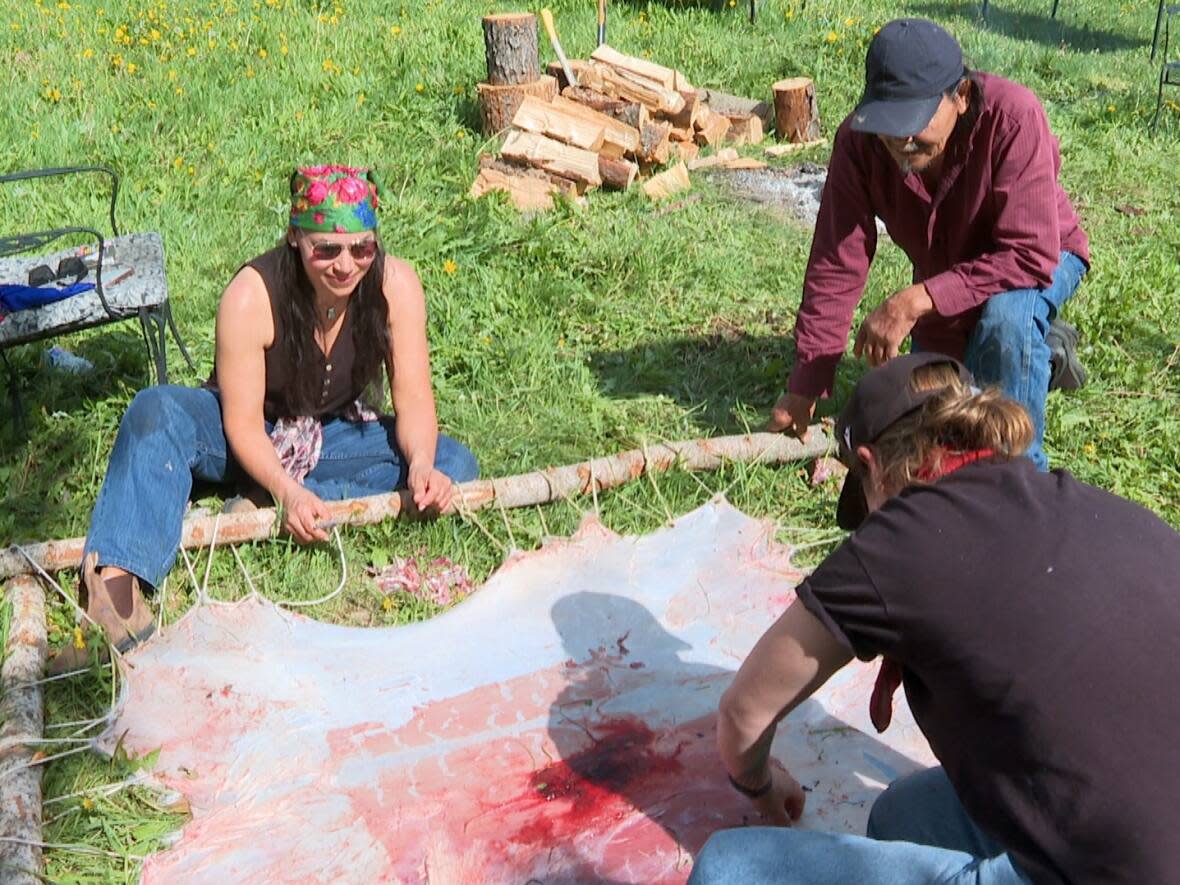Traditional Indigenous hide tanning course helps community heal, says organizer

A group of students look on attentively as Tsuut'ina elder Larry Mistaken Chief cuts holes into the edges of a fresh deer hide.
They're at One Spot Crossing near Bragg Creek, Alta., taking part in a two-day course on traditional Indigenous hide tanning that happened over the weekend.
Mistaken Chief is one to learn from — now 71, he started helping his grandmother tan hides when he was about nine years old.
He sells his hides to mostly Indigenous customers across the country, some as far north as Yellowknife.
"I'd just like to pass [it] on to a lot of people because it's a real enjoyable thing to do," Mistaken Chief said.

The ancestral way of hide tanning that Mistaken Chief is showing students starts with removing any flesh from the hide before soaking it in a large drum of water.
When the hair begins to fall off the hide, it's re-stretched on a frame before a solution made from the animal's brain matter is applied.
After that, the hide sits in the sun for four to five days. As the brain solution is absorbed, the hide is tanned.
Students attending the course got hands-on experience working with three different hides at different stages in the tanning process.
"It's all natural and it's all handmade, you know. No machines involved," Mistaken Chief said.
Reconnecting to ancestral ways
Alberta Land Based Education, which put on the course, is an organization that seeks to empower its students with traditional curriculum.
It was founded by Kelly Gordon, who is Inuvialuit and originally from the N.W.T., while she was pursuing her business degree at Mount Royal University.

Gordon wanted to gain more first-hand knowledge of Indigenous teachings. Since forming a partnership with the family that lives at Onespot Crossing, she has plans to offer more traditional classes like this one.
She said that courses offered by Alberta Land Based Education are open to Indigenous and non-Indigenous students alike.
Most of those who come to a course to learn from an elder almost always come back asking for more, Gordon said.
"People want to go hunting now, people want to build prototypes for knife scraping, people want to learn how to make dry meat. It's endless."
One day, Gordon would like to see Alberta Land Based Education become a university accredited course.
Dakota Davis, who is Dene-Cree and lives in Calgary, said she found out about the course through a post on Facebook.
Davis said the experience has gone beyond her expectations.
"I had been hunting before, [but] to see it from the perspective of someone who works with hides — basically, it was like a whole different approach."

Davis added that there were many subtle teachings she picked up on throughout the day just through watching the elders at work.
"The whole situation was really wholesome and is really beautiful."
A source of healing
For Davis, learning the traditional way of tanning hides has been a way to give back to her father, a residential school survivor.
"Recognizing basically where he wasn't allowed to grow anymore, and be able to return to that place and grow with that."
For Gordon too, reconnecting with ancestral ways has been a way to heal from intergenerational trauma. She said her whole family attended residential school.
"This is a space where we're breaking cycles," Gordon said.
"I think we need to get out there and show what beautiful culture we have. We're beautiful people, our ways are strong and they have never been stolen, they've always been alive."
Mistaken Chief said he's glad the students are interested in learning the traditional way of hide tanning, not only because it can help them understand how their ancestors lived, but also because of the sense of accomplishment the practice brings.
"When I saw my first hide, I was amazed at what I did," Mistaken Chief said.
"It's just something that I don't want to leave [behind]. I don't want people to forget about it."


